-
Countries
-
Data and Analysis
-
Special Focus
-
Crisis Responses
Event Tracking
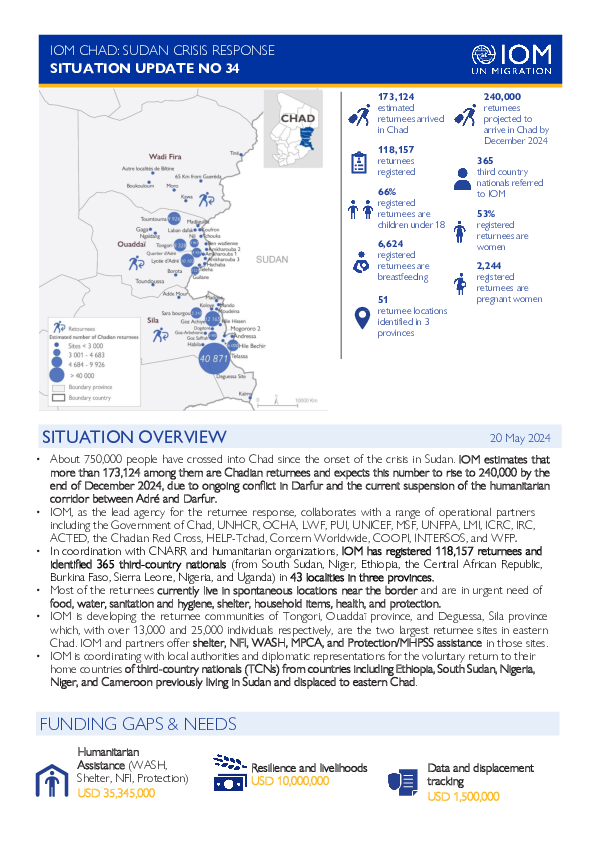
Contact
DTM Chad, dtmtchad@iom.int
Language
English
Location
Chad
Snapshot Date
May 20 2024
Activity
- Mobility Tracking
- Event Tracking
• About 750,000 people have crossed into Chad since the onset of the crisis in Sudan. IOM estimates that more than 173,124 among them are Chadian returnees and expects this number to rise to 240,000 by the end of December 2024, due to ongoing conflict in Darfur and the current suspension of the humanitarian corridor between Adré and Darfur.
• IOM, as the lead agency for the returnee response, collaborates with a range of operational partners including the Government of Chad, UNHCR, OCHA, LWF, PUI, UNICEF, MSF, UNFPA, LMI, ICRC, IRC, ACTED, the Chadian Red Cross, HELP-Tchad, Concern Worldwide, COOPI, INTERSOS, and WFP.
• In coordination with CNARR and humanitarian organizations, IOM has registered 118,157 returnees and identified 365 third-country nationals (from South Sudan, Niger, Ethiopia, the Central African Republic, Burkina Faso, Sierra Leone, Nigeria, and Uganda) in 43 localities in three provinces.
• Most of the returnees currently live in spontaneous locations near the border and are in urgent need of food, water, sanitation and hygiene, shelter, household items, health, and protection.
• IOM is developing the returnee communities of Tongori, Ouaddaï province, and Deguessa, Sila province which, with over 13,000 and 25,000 individuals respectively, are the two largest returnee sites in eastern Chad. IOM and partners offer shelter, NFI, WASH, MPCA, and Protection/MHPSS assistance in those sites.
• IOM is coordinating with local authorities and diplomatic representations for the voluntary return to their home countries of third-country nationals (TCNs) from countries including Ethiopia, South Sudan, Nigeria, Niger, and Cameroon previously living in Sudan and displaced to eastern Chad.
Contact
DTM Yemen, iomyemendtm@iom.int
Location
Yemen
Activity
- Mobility Tracking
- Event Tracking
Period Covered
Jun 02 2024 -Jun 08 2024
From 1 January to 8 June 2024, IOM Yemen DTM tracked 1,530 households (HH) (9,180 Individuals) who experienced displacement at least once.
Between 2 and 8 June 2024, IOM Yemen DTM tracked 38 households (228 individuals) displaced at least once. The majority of people moved into/within the following governorates and districts:
- Ma’rib (22 HHs) – Marib City (13 HHs), Marib (7 HHs), Harib (2 HHs) districts. Most displacements in the governorate originated from Marib and Al Hodeidah.
- Ta’iz (9 HHs) – Mawza (4 HHs), As Silw (4 HHs), Jabal Habashi (1 HHs) districts. Most displacements in the governorate originated from Taiz and Aden.
- Al Hodeidah (7 HHs) – Al Khukhah (6 HHs), Hays (1 HHs) districts. Most displacements in the governorate were internal.
The majority of people moved from the following governorates and districts:
- Al Hodeidah (9 HHs) – Al Marawiah (2 HHs), Bayt Al Faqih (2 HHs), Al Hawak (1 HHs) districts.
- Ta’iz (7 HHs) – Maqbanah (5 HHs), Al Mawasit (2 HHs) districts.
- Marib (4 HHs) – Sirwah (1 HHs), Rahabah (1 HHs), Harib (1 HHs) districts.
Population Groups
IDPs
Returnee (Previously Internally Displaced)
Survey Methodology
Unit of Analysis Or Observation
Admin Area 2
Household
Type of Survey or Assessment
Household
Key Informant
Keywords
Geographical Scope Partial Coverage
Administrative boundaries with available data
The current dataset covers the following administrative boundaries
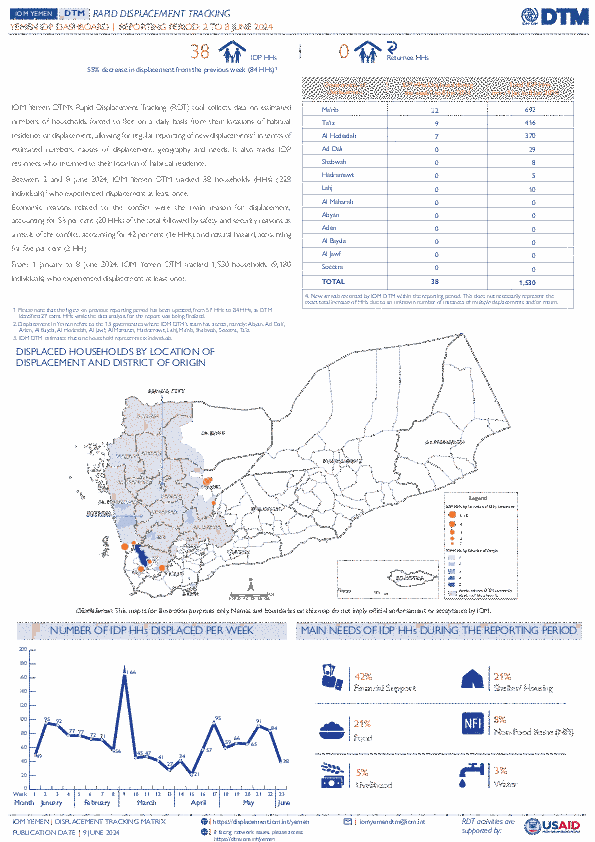
Contact
DTM Yemen, iomyemendtm@iom.int
Language
English
Location
Yemen
Period Covered
Jun 02 2024
Jun 08 2024
Activity
- Mobility Tracking
- Event Tracking
IOM Yemen DTM’s Rapid Displacement Tracking (RDT) tool collects data on estimated numbers of households forced to flee on a daily basis from their locations of origin or displacement, allowing for regular reporting of new displacements in terms of estimated numbers, geography, and needs. It also tracks returnees who returned to their location of origin.
From 1 January to 8 June 2024, IOM Yemen DTM tracked 1,530 households (HH) (9,180 Individuals) who experienced displacement at least once.
Between 2 and 8 June 2024, IOM Yemen DTM tracked 38 households (228 individuals) displaced at least once. The majority of people moved into/within the following governorates and districts:
- Ma’rib (22 HHs) – Marib City (13 HHs), Marib (7 HHs), Harib (2 HHs) districts. Most displacements in the governorate originated from Marib and Al Hodeidah.
- Ta’iz (9 HHs) – Mawza (4 HHs), As Silw (4 HHs), Jabal Habashi (1 HHs) districts. Most displacements in the governorate originated from Taiz and Aden.
- Al Hodeidah (7 HHs) – Al Khukhah (6 HHs), Hays (1 HHs) districts. Most displacements in the governorate were internal.
The majority of people moved from the following governorates and districts:
- Al Hodeidah (9 HHs) – Al Marawiah (2 HHs), Bayt Al Faqih (2 HHs), Al Hawak (1 HHs) districts.
- Ta’iz (7 HHs) – Maqbanah (5 HHs), Al Mawasit (2 HHs) districts.
- Marib (4 HHs) – Sirwah (1 HHs), Rahabah (1 HHs), Harib (1 HHs) districts.
IOM identified 27 additional households displaced in the previous reporting period, which covered 26 May - 01 June 2024, in the governorates of Taiz (12 HHs), Marib (12 HHs), and Al Hodeidah (3 HHs). These figures have been added to the cumulative displacement total recorded since the beginning of the year.

Contact
DTM Sudan; dtmsudan@iom.int
Language
English
Location
Sudan
Period Covered
Apr 01 2024
May 31 2024
Activity
- Mobility Tracking
- Event Tracking
This report represents an overview of DTM Early Warning Flash Alerts published between April and May 2024.
DTM Sudan released 62 flash alerts reporting on incidents of sudden displacement between April and May 2024, including incidents related to armed clashes (23 incidents), natural disasters (21 incidents), attacks or fears of attacks (16 incidents), and inter-communal conflicts (2 incidents). States with the most reported incidents were: North Darfur (23 incidents), North Kordofan (9 incidents), and South Kordofan (7 incidents).
Notably, DTM Sudan published more flash alerts during April and May 2024 than any other two-month reporting period since the onset of conflict on 15 April 2023, publishing twice as many alerts compared to February and March 2024 (31 published flash alerts). The increase primarily reflected the escalation in clashes across Al Fasher, North Darfur.
Note: DTM Sudan regularly releases Early Warning Flash Alerts to report on specific incidents that triggered or may trigger sudden displacement in Sudan. Flash alerts provide preliminary estimates of displacement figures due to a specific incidents. Figures in flash alerts therefore may or may not be indicative of broader displacement dynamics. More comprehensive information about displacement and mobility in Sudan is available in the Sudan Mobility Update. Early Warning Flash Alerts are distributed via the DTM Sudan mailing list.
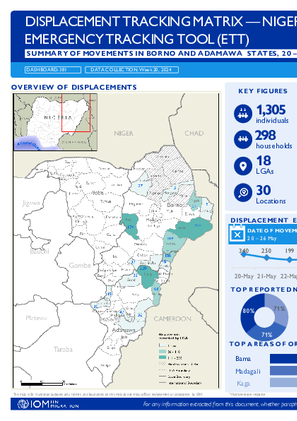
Contact
DTM Nigeria, iomnigeriadtm@iom.int
Language
English
Location
Nigeria
Period Covered
May 20 2024
May 26 2024
Activity
- Mobility Tracking
- Event Tracking
Between 20 and 26 May 2024, a total of 1,305 new arrivals were recorded at locations in Adamawa and Borno states. The new arrivals were recorded at locations in Askira/Uba, Bama, Gubio, Gwoza, Kaga, Kala Balge, Monguno and Ngala Local Government Areas (LGAs) of the most conflict-affected Borno State and in Fufore, Gombi, Guyuk, Hong, Lamurde, Madagali, Maiha, Michika, Yola North and Yola South LGAs of Adamawa State.
ETT assessments identified the following movement triggers: military operations (306 individuals or 23%), poor living conditions (275 individuals or 21%), fear of attack (245 individuals or 19%), seasonal farming (243 individuals or 19%) improved security (150 individuals or
11%) and family re-unification (86 individuals or 7%).
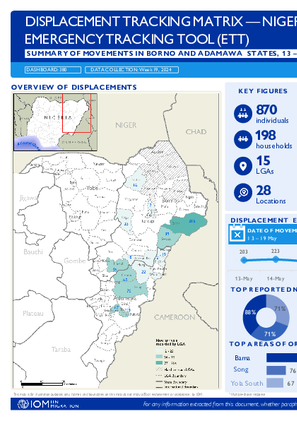
Contact
DTM Nigeria, iomnigeriadtm@iom.int
Language
English
Location
Nigeria
Period Covered
May 13 2024
May 19 2024
Activity
- Mobility Tracking
- Event Tracking
Between 13 and 19 May 2024, a total of 870 new arrivals were recorded at locations in Adamawa and Borno states. The new arrivals were recorded at locations in Askira/Uba, Bama, Gubio, Gwoza, Hawul, Jere, and Kaga Local Government Areas (LGAs) of the most conflict-affected Borno State and in Gombi, Hong, Madagali, Michika, Mubi South, Song, Yola North and Yola South LGAs of Adamawa State.
ETT assessments identified the following movement triggers: improved security (276 individuals or 32%), seasonal farming (154 individuals or 18%), military operations (143 individuals or 16%), poor living conditions (126 individuals or 14%), family re-unification (102 individuals or 12%), fear of attack (44 individuals or 5%) and attack (25 individuals or 3%).
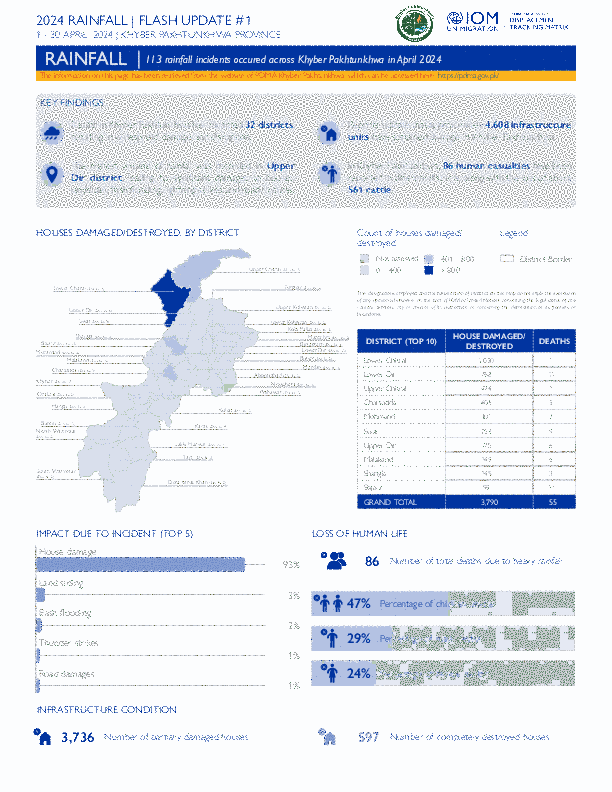
Contact
DTMPakistan@iom.int
Language
English
Location
Pakistan
Period Covered
Apr 01 2024
Apr 30 2024
Activity
- Event Tracking
Rainfall in Khyber Pakhtunkhwa has impacted 32 districts, resulting in widespread damage and disruption. Reports indicate that approximately 4,608 infrastructure units have sustained damage in Khyber Pakhtunkhwa. The highest volume of rainfall was recorded in Upper Dir district, leading to significant damages to houses, landslides, flash flooding, lightning strikes, and road closures. In Khyber Pakhtunkhwa, 86 human casualties have been reported in different districts, along with the loss of about 561 cattle.
Contact
DTM Yemen, iomyemendtm@iom.int
Location
Yemen
Activity
- Mobility Tracking
- Event Tracking
Period Covered
May 26 2024 -Jun 01 2024
From 1 January to 1 June 2024, IOM Yemen DTM tracked 1,465 households (HH) (8,790 Individuals) who experienced displacement at least once.
Between 26 May and 1 June 2024, IOM Yemen DTM tracked 57 households (342 individuals) displaced at least once. The majority of people moved into/within the following governorates and districts:
- Ma’rib (38 HHs) – Ma’rib City (19 HHs), Ma’rib (14 HHs), Harib (5 HHs) districts. Most displacements in the governorate originated from Ta’iz and Al Hodeidah.
- Shabwah (8 HHs) – Bayhan (8 HHs) district. All displacements in the governorate originated from Al Bayda.
- Ta’iz (6 HHs) – Al Makha (3 HHs), Al Misrakh (2 HHs), Jabal Habashi (1 HH) districts. Most displacements in the governorate originated from Ta’iz and Al Hodeidah.
The majority of people moved from the following governorates and districts:
- Ta’iz (12 HHs) – Mawza (3 HHs), As Silw (3 HHs), Maqbanah (1 HH) districts.
- Al Hodeidah (9 HHs) – Ad Durayhimi (2 HHs), Az Zuhrah (1 HH), Jabal Ras (1 HH) districts.
- Al Bayda (8 HHs) – Numan (4 HHs), Nati (4 HHs) districts.
Population Groups
IDPs
Returnee (Previously Internally Displaced)
Survey Methodology
Unit of Analysis Or Observation
Admin Area 2
Household
Site or Location
Type of Survey or Assessment
Household
Key Informant
Keywords
Geographical Scope Partial Coverage
Administrative boundaries with available data
The current dataset covers the following administrative boundaries
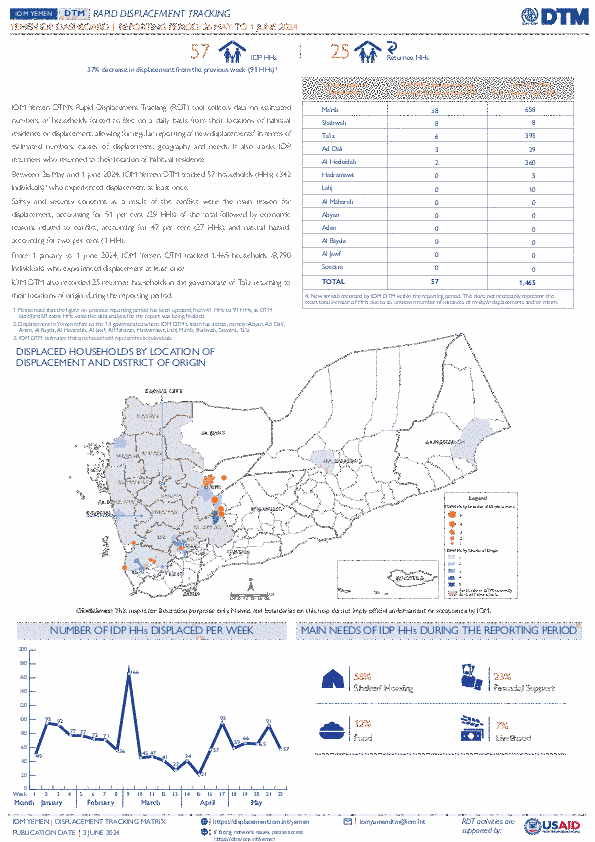
Contact
DTM Yemen, iomyemendtm@iom.int
Language
English
Location
Yemen
Period Covered
May 26 2024
Jun 01 2024
Activity
- Mobility Tracking
- Event Tracking
IOM Yemen DTM’s Rapid Displacement Tracking (RDT) tool collects data on estimated numbers of households forced to flee on a daily basis from their locations of origin or displacement, allowing for regular reporting of new displacements in terms of estimated numbers, geography, and needs. It also tracks returnees who returned to their location of origin.
From 1 January to 1 June 2024, IOM Yemen DTM tracked 1,465 households (HH) (8,790 Individuals) who experienced displacement at least once.
Between 26 May and 1 June 2024, IOM Yemen DTM tracked 57 households (342 individuals) displaced at least once. The majority of people moved into/within the following governorates and districts:
- Ma’rib (38 HHs) – Ma’rib City (19 HHs), Ma’rib (14 HHs), Harib (5 HHs) districts. Most displacements in the governorate originated from Ta’iz and Al Hodeidah.
- Shabwah (8 HHs) – Bayhan (8 HHs) district. All displacements in the governorate originated from Al Bayda.
- Ta’iz (6 HHs) – Al Makha (3 HHs), Al Misrakh (2 HHs), Jabal Habashi (1 HH) districts. Most displacements in the governorate originated from Ta’iz and Al Hodeidah.
The majority of people moved from the following governorates and districts:
- Ta’iz (12 HHs) – Mawza (3 HHs), As Silw (3 HHs), Maqbanah (1 HH) districts.
- Al Hodeidah (9 HHs) – Ad Durayhimi (2 HHs), Az Zuhrah (1 HH), Jabal Ras (1 HH) districts.
- Al Bayda (8 HHs) – Numan (4 HHs), Nati (4 HHs) districts.
IOM identified 50 additional households displaced in the previous reporting period, which covered 19 - 25 May 2024, in the governorates of Ta’iz (35 HHs), Ma’rib (11 HHs), and Al Hodeidah (4 HHs). These figures have been added to the cumulative displacement total recorded since the beginning of the year.

Contact
DTM Sudan, DTMSudan@iom.int
Language
English
Location
Sudan
Period Covered
Apr 01 2024
May 31 2024
Activity
- Other
- Mobility Tracking
- Event Tracking
Since 01 April 2024, DTM monitored numerous clashes across Al Fasher and other localities in North Darfur state. According to DTM field teams, clashes triggered widespread displacement across North Darfur state. As of 31 May 2024, approximately 129,825 individuals (approximately 25,965 households) were displaced in Al Fasher locality due to the numerous clashes since 01 April 2024.
The Focused Flash Alert provides a numeric breakdown of population estimates affected by the recent escalations from 01 April -31 May 2024. All figures should be understood as preliminary estimates, pending further verification.
DTM Sudan releases Early Warning Flash Alerts to provide immediate updates on specific incidents or armed clashes that spurred displacement. Early Warning Flash Alerts are distributed via the DTM Sudan mailing list. For more information, see Focused Flash Alert North Darfur (Update 001).
Pagination
- Previous page
- Page 28
- Next page
